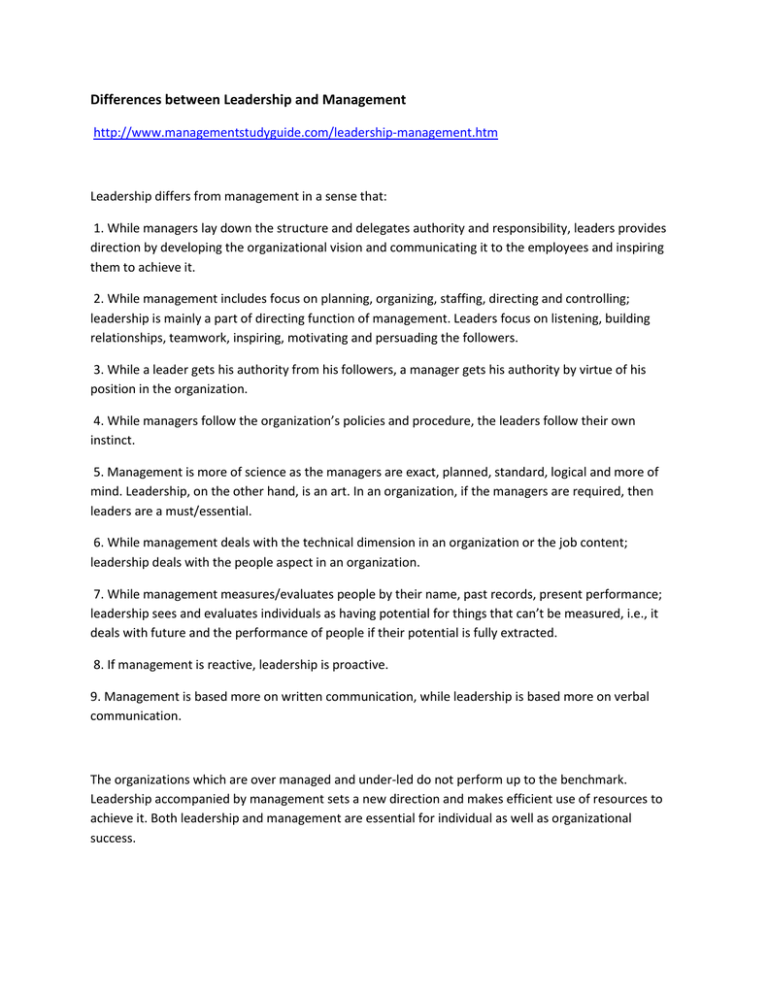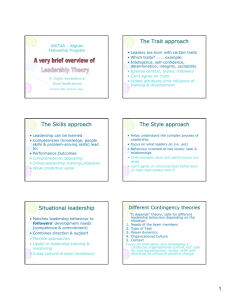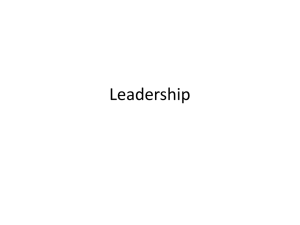Differences between Leadership and Management
advertisement

Differences between Leadership and Management http://www.managementstudyguide.com/leadership-management.htm Leadership differs from management in a sense that: 1. While managers lay down the structure and delegates authority and responsibility, leaders provides direction by developing the organizational vision and communicating it to the employees and inspiring them to achieve it. 2. While management includes focus on planning, organizing, staffing, directing and controlling; leadership is mainly a part of directing function of management. Leaders focus on listening, building relationships, teamwork, inspiring, motivating and persuading the followers. 3. While a leader gets his authority from his followers, a manager gets his authority by virtue of his position in the organization. 4. While managers follow the organization’s policies and procedure, the leaders follow their own instinct. 5. Management is more of science as the managers are exact, planned, standard, logical and more of mind. Leadership, on the other hand, is an art. In an organization, if the managers are required, then leaders are a must/essential. 6. While management deals with the technical dimension in an organization or the job content; leadership deals with the people aspect in an organization. 7. While management measures/evaluates people by their name, past records, present performance; leadership sees and evaluates individuals as having potential for things that can’t be measured, i.e., it deals with future and the performance of people if their potential is fully extracted. 8. If management is reactive, leadership is proactive. 9. Management is based more on written communication, while leadership is based more on verbal communication. The organizations which are over managed and under-led do not perform up to the benchmark. Leadership accompanied by management sets a new direction and makes efficient use of resources to achieve it. Both leadership and management are essential for individual as well as organizational success. Leader v Manager http://www.managementstudyguide.com/leader_versus_manager.htm “Leadership and managership are two synonymous terms” is an incorrect statement. Leadership doesn’t require any managerial position to act as a leader. On the other hand, a manager can be a true manager only if he has got the traits of leader in him. By virtue of his position, manager has to provide leadership to his group. A manager has to perform all five functions to achieve goals, i.e., Planning, Organizing, Staffing, Directing, and Controlling. Leadership is a part of these functions. Leadership as a general term is not related to managership. A person can be a leader by virtue of qualities in him. For example: leader of a club, class, welfare association, social organization, etc. Therefore, it is true to say that, “All managers are leaders, but all leaders are not managers.” A leader is one who influences the behavior and work of others in group efforts towards achievement of specified goals in a given situation. On the other hand, manager can be a true manager only if he has got traits of leader in him. Manager at all levels are expected to be the leaders of work groups so that subordinates willingly carry instructions and accept their guidance. A person can be a leader by virtue of all qualities in him. Leaders and Managers can be compared on the following basis: Basis Manager Leader Origin A person becomes a manager by virtue of his position. A person becomes a leader on basis of his personal qualities. Formal Rights Manager has got formal rights in an organization because of his status. Rights are not available to a leader. Followers The subordinates are the followers of managers. The group of employees whom the leaders leads are his followers. Functions A manager performs all five functions of management. Leader influences people to work willingly for group objectives. Necessity A manager is very essential to a concern. A leader is required to create cordial relation between person working in and for organization. Stability It is more stable. Leadership is temporary. Mutual Relationship All managers are leaders. All leaders are not managers. Accountability Manager is accountable for self and subordinates behaviour and performance. Leaders have no well defined accountability. Concern A manager’s concern is organizational goals. A leader’s concern is group goals and member’s satisfaction. Followers People follow manager by virtue of job description. People follow them on voluntary basis. Role continuation A manager can continue in office till he performs his duties satisfactorily in congruence with organizational goals. A leader can maintain his position only through day to day wishes of followers. Sanctions Manager has command over allocation and distribution of sanctions. A leader has command over different sanctions and related task records. These sanctions are essentially of informal nature. Authority v Leadership http://www.managementstudyguide.com/authority-and-leadership.htm The authority exercised is a kind of legitimate power and people follow figures exercising it, because their positions demand so irrespective of the person holding the position. Leaders in organizations and elsewhere may have formal authorities but they mostly rely on the informal authority that they exercise on people to influence them. Leaders are trusted for their judgment and respected for their expertise, integrity etc and hence followed and not because they hold a certain position. For e.g. M.K. Gandhi for most part did not hold any official position to lead the Indian freedom struggle. It is also important to understand that a formal authority and power emerging from it, might not always be able to influence people in the desired manner as; in times of crisis and difficulties people view it as coercion. On the other hand leadership tends to create followers out of free will and choice without forcing them to accept anything thrown their way. Authority rarely provides a scope for feedback, constructive criticism or opinions of the people on whom it is exercised however leaders provide ample platform to their followers to voice their thoughts and feedback. When dealing with adults, the sole use of authority to direct and discipline them hardly works, leadership provides a better approach of sharing and involving thus building rapports with followers and creating long term relationships. Authority can hardly make people change their attitudes and behaviors with lasting effects and results however a leader inspires followers through self modeled ways and hence leadership displays greater effectiveness in addressing attitudes and behaviors of people. Exercising authority sometimes limits the approaches to arrive at solutions for issues and problems while leadership encourages people to look beyond the obvious and think innovatively and sometimes emerge with radical solutions. Apart from it, the biggest difference between the two as cited by Stephen R Covey is the moral authority held by leaders over the followers which is absent in the case of power from authority. Within the organizational setup when leaders also have moral authority on their subordinates by establishing a synchrony in their words and actions; the rest of the structure and processes of the organization also get aligned to it, thus creating a robust and transparent culture. Authoritative way of working also encourages individuals to work in silos while in the organizations of today; the leaders need to have a complete picture and coordinate with other functions and departments as and when required. It is indeed difficult for mangers and leaders to move out of their circle of authority and coordinate and interact with external people. However the need of the hour and the more effective approach to leadership and management is when leaders come out of their comfort zone and move from exercising authority on a small group to leading the entire organization. Individuals, who do not rely on authority but lead people, are the ones who enjoy the privilege of their ideologies and thoughts practiced by later generations long after they are gone. Even with individuals who held positions of responsibilities, the ones who actually led their people are the ones remembered and followed. LEADERS ALWAYS BUILD CULTURE: http://www.revivallifestyle.com/controlling-vs-empowering-leadership-styles/ The sum of every leader’s actions is the “environment” or “culture” he or she is creating within his or her area of influence. Whatever you do as a leader, is always communicating something to your followers – verbally AND non-verbally. Actions can speak louder than words as you certainly know. On a very general basis we can divide leaders and the “environments” they’re building into 2 different categories: 1. Controlling: Extreme examples are dictators, captains of slave ships or others who don’t give a dime about somebody else’s opinion, use fear of punishment as primary motivation and force to execute their will. 2. Empowering: These leaders have in common that they have very high values for individuals and their opinions. That’s why they encourage critical thinking and in turn get blessed with highly innovative, motivated followers. They understand that they are most effective when their followers are the most empowered. This way their goal becomes finding the perfect spot for every individual’s gift- and talentmix, celebrating great ideas and honoring excellent workers. The difference is pretty obvious in these extreme examples. In real life however leaders find themselves somewhere in-between these two extremes, oftentimes not even aware of how empowering or controlling they are and how much of the potential of their followers they release or hold back. Let me give you an example out of the real world to make my point even clearer. EXAMPLE – GM vs. TOYOTA: In the 1980′s a typical General Motors Factory was the perfect stereotype of an assembly line. Hierarchy was strict and clear, every worker was performing only one task and if an employee made or noticed a mistake, he had to push a red button, whereupon a loud alarm would sound. Everybody would rush together under pressure and try to fix the issue as fast as possible. The quality of cars produced by GM in the 80′s however, was at best okay. At the same time Toyota developed a different model of production assembly line. Employees were regarded as members of a team, and each team member was considered an important contributor and given a high level of autonomy. What happened if an employee stopped the line, because he discovered a failure? A pleasant “ding-dong” would sound and teams would carefully study what went wrong in an effort to continually improve the process. Simple Line workers were constantly encouraged to make suggestions and – I know this is hard to believe – 100% of all suggestions were implemented by the management! Rather than regarding the line workers as drones, who had to follow orders without asking question, Toyota viewed its employees as Key Assets! Imagine the line worker’s feeling of empowerment, as they experienced that their opinions mattered! The result of this drastically different leadership style, Toyota’s cars were of dramatically higher quality than the vehicles produced by GM. The difference soon became so obvious that the heads of GM decided to give one of their worst factories, that was short before closure, to Toyota and see what they can make out of it. Toyota accepted the challenge and the results were staggering! Although Toyota was using the exact same workers and materials, within three years the factory had become one of GM’s most efficient! It’s productivity was 60% higher than any other GM plants. What had happened? Because of the new, empowering leadership structure Toyota applied workers who had been demotivated and lacy before, now felt like an important part of a team and acted like it. If a worker was showing up late, or worked poorly he’d get corrected by his team members! The management barely needed to enforce any control, because of the high level of integrity. Since every opinion was valued and taken serious, workers would start to be creative and innovative. Qualities of a Leader http://www.managementstudyguide.com/qualities_of_a_leader.htm A leader has got multidimensional traits in him which makes him appealing and effective in behavior. The following are the requisites to be present in a good leader: 1. Physical appearance- A leader must have a pleasing appearance. Physique and health are very important for a good leader. 2. Vision and foresight- A leader cannot maintain influence unless he exhibits that he is forward looking. He has to visualize situations and thereby has to frame logical programs. 3. Intelligence- A leader should be intelligent enough to examine problems and difficult situations. He should be analytical who weighs pros and cons and then summarizes the situation. Therefore, a positive bent of mind and mature outlook is very important. 4. Communicative skills- A leader must be able to communicate the policies and procedures clearly, precisely and effectively. This can be helpful in persuasion and stimulation. 5. Objective- A leader has to be having a fair outlook which is free from bias and which does not reflects his willingness towards a particular individual. He should develop his own opinion and should base his judgment on facts and logic. 6.Knowledge of work- A leader should be very precisely knowing the nature of work of his subordinates because it is then he can win the trust and confidence of his subordinates. 7. Sense of responsibility- Responsibility and accountability towards an individual’s work is very important to bring a sense of influence. A leader must have a sense of responsibility towards organizational goals because only then he can get maximum of capabilities exploited in a real sense. For this, he has to motivate himself and arouse and urge to give best of his abilities. Only then he can motivate the subordinates to the best. 8. Self-confidence and will-power- Confidence in himself is important to earn the confidence of the subordinates. He should be trustworthy and should handle the situations with full will power. (You can read more about Self-Confidence at : Self Confidence - Tips to be Confident and Eliminate Your Apprehensions). 9. Humanist-This trait to be present in a leader is essential because he deals with human beings and is in personal contact with them. He has to handle the personal problems of his subordinates with great care and attention. Therefore, treating the human beings on humanitarian grounds is essential for building a congenial environment. 10. Empathy- It is an old adage “Stepping into the shoes of others”. This is very important because fair judgment and objectivity comes only then. A leader should understand the problems and complaints of employees and should also have a complete view of the needs and aspirations of the employees. This helps in improving human relations and personal contacts with the employees. From the above qualities present in a leader, one can understand the scope of leadership and it’s importance for scope of business. A leader cannot have all traits at one time. But a few of them helps in achieving effective results. Traits of an Ethical Leader http://www.managementstudyguide.com/leadership-ethics.htm Ethics refer to the desirable and appropriate values and morals according to an individual or the society at large. Ethics deal with the purity of individuals and their intentions. Ethics serve as guidelines for analyzing “what is good or bad” in a specific scenario. Correlating ethics with leadership, we find that ethics is all about the leader’s identity and the leader’s role. Ethical theories on leadership talk about two main things: (a) The actions and behaviour of leaders; and (b) the personality and character of leaders. It is essential to note that “Ethics are an essential to leadership”. A leader drives and influences the subordinates / followers to achieve a common goal, be it in case of team work, organizational quest, or any project. It is an ethical job of the leader to treat his subordinates with respect as each of them has unique personality. The ethical environment in an organization is built and developed by a leader as they have an influential role in the organization and due to the fact that leaders have an influence in developing the organizational values. An effective and ethical leader has the following traits / characteristics: Dignity and respectfulness: He respects others. An ethical leader should not use his followers as a medium to achieve his personal goals. He should respect their feelings, decision and values. Respecting the followers implies listening effectively to them, being compassionate to them, as well as being liberal in hearing opposing viewpoints. In short, it implies treating the followers in a manner that authenticate their values and beliefs. Serving others: He serves others. An ethical leader should place his follower’s interests ahead of his interests. He should be humane. He must act in a manner that is always fruitful for his followers. Justice: He is fair and just. An ethical leader must treat all his followers equally. There should be no personal bias. Wherever some followers are treated differently, the ground for differential treatment should be fair, clear, and built on morality. Community building: He develops community. An ethical leader considers his own purpose as well as his followers’ purpose, while making efforts to achieve the goals suitable to both of them. He is considerate to the community interests. He does not overlook the followers’ intentions. He works harder for the community goals. Honesty: He is loyal and honest. Honesty is essential to be an ethical and effective leader. Honest leaders can be always relied upon and depended upon. They always earn respect of their followers. An honest leader presents the fact and circumstances truly and completely, no matter how critical and harmful the fact may be. He does not misrepresent any fact. It is essential to note that leadership is all about values, and it is impossible to be a leader if you lack the awareness and concern for your own personal values. Leadership has a moral and ethical aspect. These ethics define leadership. Leaders can use the above mentioned traits as yardsticks for influencing their own behavior. The Two Kinds of Leadership December 7, 2010 Does your personal leadership style more closely resemble Adolph Hitler or Winston Churchill? If you had been around in the 1930s and ’40s, which one would you have followed? The answer may not be as clear-cut as you think. In a fascinating book comparing the leadership styles of the two men, historian Andrew Roberts concludes that there are two basic types of leadership—charismatic and inspirational. Here is a comparison of the two styles. See which one appeals to you. Personality Charismatic leaders want to be liked. They have great personal magnetism and are very engaging. When you are around them, you believe what they say and find yourself wanting to please them. Their followers are extremely loyal. Inspirational leaders don’t care what people think of them. They may be less likeable because they are more focused on their goal than on winning friends. Motivation Charismatic leaders often rely on negative motivation. They may appeal to anger, resentment, or a sense of having been wronged. Because these motivators are very powerful, they are likely to have a strong following. Inspirational leaders nearly always use positive motivation. They are likely to call for sacrifice and commitment in pursuit of a common good. As a result, it may take them longer to gain followers. Personal Appearance Charismatic leaders crave the appearance of control. They are careful to present themselves flawlessly and fear appearing weak or wrong. Inspirational leaders are less concerned with personal dignity because they are pointing to something beyond themselves. Staffing Charismatic leaders want to be the lone star. They often hire people who are less competent than they are. They may tolerate personal weakness or even incompetence in subordinates provided that they are highly loyal. Inspirational leaders enjoy creative tension. They are not afraid to hire people who are smarter or more talented than they are, even those who may disagree with them. Results matter more to them than personal allegiance. Delegation Charismatic leaders have one idea. They are focused on a single dream and care little about the process for achieving it. If they delegate at all, it will be an outcome, not a method for achieving it. Inspirational leaders have many ideas about process as well as outcome. They are more likely to be involved in management and may be accused of micromanaging. Structure Charismatic leaders prefer silos. They avoid giving too much authority to any person or department and may encourage rivalry among subordinates. Inspirational leaders streamline processes. They are more likely to delegate authority down the chain of command because results matter more to them than personal loyalty. By now you may have figured out that Hitler was the charismatic leader and Churchill the inspirational one. It should be clear that the term charismatic is not synonymous with likeable, and inspirational does not equate to inspiring. The terms simply describe the foundational aspect of one’s leadership. Does the leader draw others toward him or point others toward something bigger?






